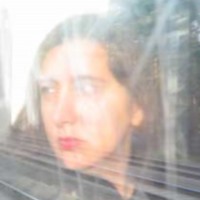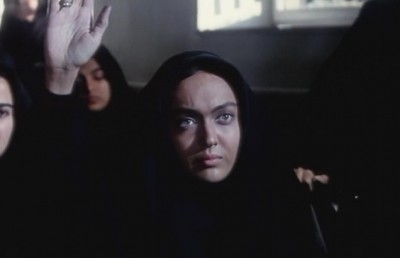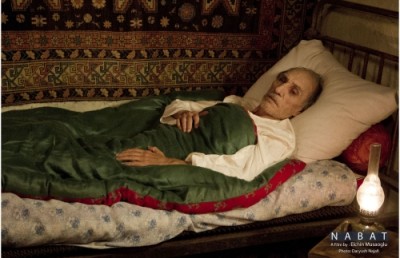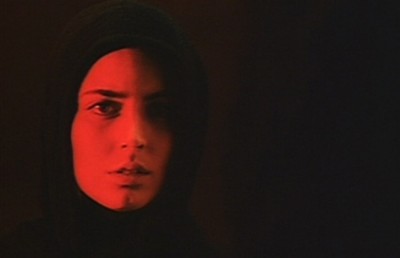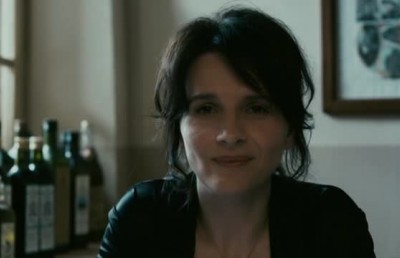Pictura Poesis: The interplay of poetry, image and ethnography in Forough Farrokhzad’s The House is Black
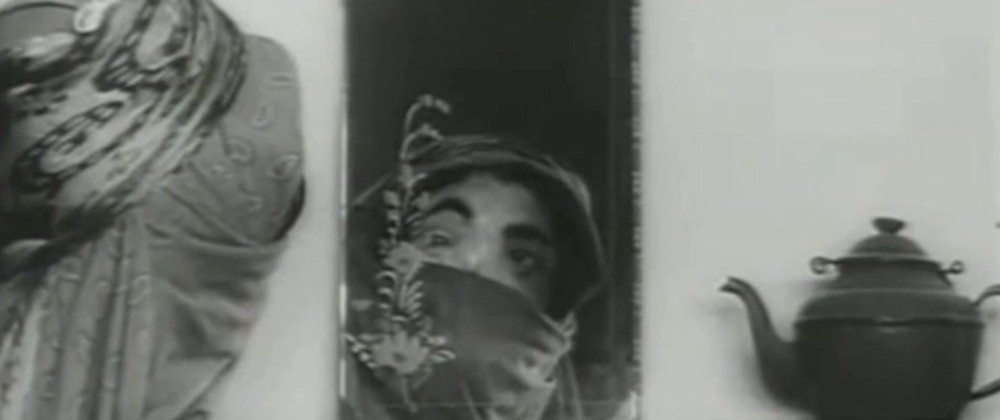
It’s a misconception to think that religious propaganda, censorship laws and social restrictions (sex, violence, flesh as taboo filmic subjects) in post-Revolution Iran are responsible for the creation of an Iranian cinema akin to Italian neorealism and the French New Wave. After the Revolution heavy restrictions were placed on publishing and in the wake of this censorship the “language of images” did move increasingly from text to celluloid. When writers were restricted, cinema stepped in to offer another language, which functioned primarily as metaphor. Iranian cinema became a major player on the International film scene. A success, due in part to a strong foundation in Persian poetry and language —famous for its intricacy and beauty and above all its ability to conceal and reveal simultaneously. This filmic tradition, while heightened after the Revolution, did not begin with the Revolution but well before it with works like that of Iranian poet, Forough Farrokhzad.
Farrokhzad was a pioneer in Persian poetry and at the forefront of the modernist movement in Iran. Important Iranist and editor of Encyclopedia Iranica, Professor Ehsan Yarshater commented to me that Persian poetry seems to have died with the Revolution. He also lamented that had pioneering poet Forough Farrokhzad not died prematurely (she was killed in a car crash in 1967 at the age of 36) she would have been the greatest Iranian poet of the twentieth century. I’d argue that she remains one of the greatest Persian poets of the last century and that poetry hasn’t died, but has found a new medium in cinema. 1 For Farrokhzad poetry was a way of seeing, of experiencing the world and voicing through symbolism and metaphor what could not be said literally. Cinema added a more vivid layer to her poetry.
Italian neorealism first came to influence Iranian cinema in the late fifties and early sixties through the work of a few key Iranian filmmakers who were also famous writers, like Bahram Bayzaii, Ebrahim Golestan and Forough Farrokhzad. It was Forough Farrokhzad’s lover, writer and filmmaker, Ebrahim Golestan who encouraged her to turn to film by sending her in 1959 to study film production and English in England. She returned to Iran and assisted him on his seminal documentary films: Water and Heat (1961), about the dizzying social and industrial ‘heat’ of the Abadan environment, and A Fire (1961), about a seventy-day oil refinery fire in Khuzestan. Based on the success of A Fire, the Shah of Iran commissioned Farrokhzad and Golestan to make a film for the benefit of the Society for Assistance to Lepers. Golestan handed Farrokhzad the project. This opportunity to play with film on her own resulted in her greatest and lesser-known achievement – which was to have facilitated the move of poetry from paper to celluloid in her brilliant and powerful short “documentary” The House is Black.
While the 60’s and 70’s were a heyday for documentary film production in Iran, most of the films that were made were censored either by the Pahlavi regime or later destroyed by the Islamic revolutionary government. Kamran Shirdel’s film, The Women’s Quarter, about Tehran’s red light district, for example was banned during the Shah’s regime –locked away in a building where it was either accidentally or intentionally burned. The film was remade with the surviving soundtrack and film stills by Ebrahim Golestan’s son Kaveh Golestan only to be confiscated by the Islamic Republic. It too was believed to have been burned, but later resurfaced. In the midst of all this censorship Farrokhzad managed to make a film that functioned as both documentary and veiled social critique.
Through the alchemical aid of celluloid and poetry she pioneered a style that brought the illusive quality of images together with poetry to create a new or what Eisenstein dubbed a third meaning. Farrokhzad shot her film on location in a leper colony outside of Tabriz, (a major city in north-west Iran near the Turkish border), but beyond this “fact” the “documentary” functions solely in the realm of metaphor where the disease of leprosy comes to stand for stagnation, inertia and a spiritual void that she felt were eating away at the core of Iranian society. 2
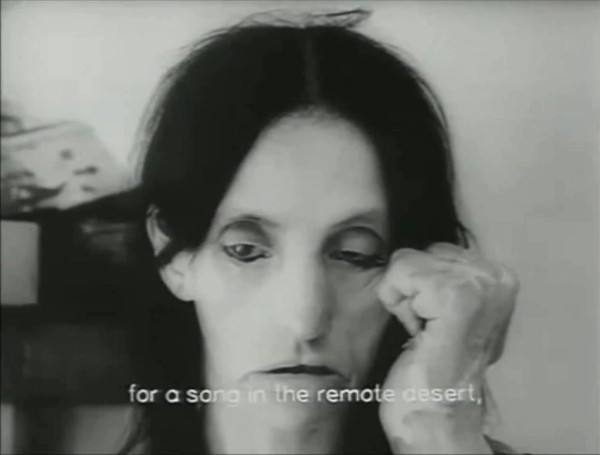
Using a clever montage of image, poetry and ethnography she wielded the metaphor of disease into a powerful social critique that was so subtle that even the Shah, whose regime was her target missed her meaning and shed very public tears at the screening on opening night. 3 Thirty-one years after its release in 1962, in 1993, represented by a country she would no longer recognize had she lived The House is Black won the grand prize at the Venice Film Festival. 4
Poetry
Extracted in full, removed from the images and printed out to its two material pages, the poem or film narrative, seems at first naked, then in reading, transformed. As words, as a text, some of which comes from the old testament of the Bible and some from the Quran, it has nothing at all to do with the social science of leprosy. Without the establishing background sounds and visual imagery of a leper colony in Tabriz, the poem no longer speaks of leprosy as such. Could Farrokhzad have written this independent of or prior to the film project? It certainly was in tune with the zeitgeist of the day that saw disease as a metaphor for society: a metaphor for ugliness, alienation and confinement.
Farrokhzad wasn’t the only writer to use disease as a metaphor for political corruption. Her Iranian contemporary, writer Jalal Ale Ahmad’s famous tome, Westoxification likened contemporary Iranian society to wheat rotting from within. Westoxification was a major influence in the anti-Shah sentiment at the time. While The House is Black uses the everyday life of lepers as a metaphor for the Shah’s oppressive social policies and a critique of the practice of religion at the time, which she saw as a form of fatalism, Ale Ahmad’s writing on the other hand suggests that religion, Islam in particular may be the solution (though he too was critical of the way it was practiced at the time).
Without making any strong attempts to describe the images or explain the lifestyle in the leper colony Farrokhzad provides more than just a recreation of a pre-filmic world with an authoritative/scientific explanation. Instead, the physical and the abstract move apart in the image and text. In film, seeing replaces touching, and yet, for some audience members the sensation of touching a festering wound will remain long after the lights dim on the last image of the film. A world of poetry and pain is created, which is at once that of the poet’s and of the leper’s.
In the beginning of the film we see a face staring into a mirror. The female face looks more like an apple eaten by worms than a face. Silence ensues as the camera moves in closer on the eye and we see that the eye is not on us but is instead fixated on the flesh that has overtaken the second eye, nose and most of the face. This isn’t a pose, for she isn’t looking at us, but at herself. According to Deleuze, “the face is a politics.” 5
For Farrokhzad, being a woman is a politics. The large degree to which Farrokhzad’s own fear of ugliness, idleness and alienation are played out in the film is corroborated through the use of similar themes and language in her poem, Reborn, which she wrote well before making the film:
All day, all day long
released, released like a corpse floating on water,
I move toward a rock verging an abyss,
toward the deepest ocean caves,
the most carnivorous fish.
The frail bones of my spine
twinged, sensing death. 6
She achieves a level of social critique in the film by never directly staging or directly naming an image in the text. The absence of the words leprous, leprosy or leper is turned on its head when coupled with photography. While leprosy is never directly named in the poetry, its symptoms are: inertia, indecision, stagnation, empty desires – in short, the same symptoms she sees plaguing her society. Social ills are shown by way of visual metaphor. Leprosy only comes to play as “the real” through the masculine voice of science during a clinic sequence when the audience is suddenly placed in a hospital clinic listening to a male Voice-Over explain the scientific and social facts of leprosy while gruesome images of wounds and treacherously painful therapies move across the screen. While the voice and narrative are completely foreign to the rest of the poetic script, the images of the lepers, and the continuation of that filmic world make this section less jolting. The clinic scene, like a wedding scene later in the film, provide the film with the authority of a documentary, or a foil for a more searing social critique of Islam, gender and modern Iranian society. 7
Will this film, can this film, wipe out ugliness in the very act of displaying it? How will the victims find relief in the touch of an outsider’s eyes penetrating their open wounds? Is it the reverse of Roland Barthe’s _punctum_… can a wound find relief in a gaze?
What is most interesting about the poetic script is that very few of the lines are “staged” in an obvious manner where an image might directly correspond to a particular word or line. Without having a written text of the poem, it is hard to define where stanzas and lines begin and end (aside from pauses and breathes). There are few graphic close-ups in the poem script where a concrete image is named. Instead there are vague feelings, ideas and images that serve as metaphors: the dove for children, prayer beads for inertia. The words barely touch on the images. The images retain their own autonomy vis-a-vis the narrative and vice versa. In his work on montage Sergei Eisenstein is clear about how the narrative will order the successive appearance of each element in the film. 8 This isn’t the case in Farrokhzad’s work. 9 Only in a few places do word and image ever directly correspond. One such instance is a scene where the woman applies mascara and Farrokhzad says:
oh, the one who time has forgotten
dressing yourself in red and wearing golden ornaments
anointing your eyes with khol, remember you have made yourself beautiful in vain
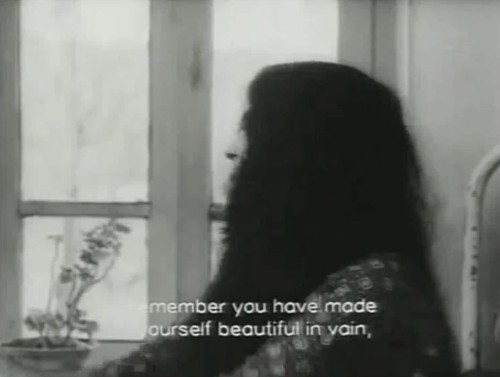
Like the rest of the poem, this stanza could apply to any modern Tehran woman and the shot may have been purely coincidental or “found” to fit perfectly later, in editing. Farrokhzad is not alive to ask whether the poem was written as a script, or whether it was written after, during editing or even months or years before any of the shots were storyboarded, found or taken. This move allows the narrative its own autonomy and opens the space for social critique. This is where Farrokhzad’s allegiance to the power of language supersedes that of imagery. It is here that we see that the images are only manipulated to screen what is too abstract in the poem to be understood fully as a social critique. An example of how the poem and film correspond indirectly is in an early line: “Who is this in hell praising you o lord,” (when the boys’ praise God, reading from a script/text). If Farrokhzad were alive we could ask if these lines were written by her to be read by the boys, or were an actual school text and whether this scene was staged. Or if it was an image-scene constructed alongside the poem’s text? The fact that the boy’s read the non-native Persian script with heavy Turkish accents suggests that the text was given to them by Farrokhzad.
Can a poem be taken for ethnography when it never names its subject? And when it so blatantly evokes emotions and manipulates images? When it is in a language foreign to the natives?
The boldness with which Farrokhzad places poetry in the space of science (as opposed to Margaret Mead’s accusation that the artistic intervention into documentary – a scientific endeavor in Mead’s opinion, ruined the ethnographic project) may only have succeeded, as it did, in isolation. Farrokhzad’s film effortlessly moves beyond Mead’s anxieties about ethnographic film and fulfills the American contemporary of Farrokhzad’s, – poet and an experimental filmmaker Maya Deren’s notion of a “poetic” cinema.
When Farrokhzad traveled to Italy to partake in a film writer’s festival in Pisaro, she wrote home to Golestan, “The sense of being outside of the flow of things is suffocating me. When I see the differences in life here, with its aware flow that moves forward with such force as to inspire and awaken constructive activity and creativity, my brain fills with blackness and despair, and I want to die.” 10 Farrokhzad lived in a heavily censored regime under the Shah and sought out the illusive quality of images, that when coupled with poetry formed new meanings. Even in her poetry she responded to her times through an art of the interior.
There are obvious themes that run parallel in her poetry and her film: death, re-birth and self-fragmentation, a creative use of reality and the concern for creating a new reality. Making reality an art and using it to a political end is preeminent in her film work.
In an interview Farrokhzad says,
Of course we compose poetry out of personal need, an irresistible calling… But what happens after we commit our poems to the page? We must be judged and feel that we have made a difference, made a connection, and that we are responsible. But how could one look fondly at, or even expect an answer from a society that is shapeless, without an ideal, refusing any sort of responsibility, it’s only movement being from a season of mating to a season of grazing? In this field, an artist’s work is private and individualistic. How long can he or she survive this isolation, conversing only with the door and the four walls? This is a question, the answer to which lies in the capacity and forbearance of each individual artist. Those who grow silent or have nothing more to say had better keep their peace, otherwise their ability to cope with the frightful sewage becomes impossible, and they find themselves abandoned and useless. The only way to survive is that one should reach such a state of detachment and maturity that he or she cannot both be a builder of and a mouthpiece for her world, both an observer and the judge. 11
Maya Deren says, “When I was writing poetry, I had constantly, to transcribe my essentially visual images — always of movements, incidents and events — into verbal form. In motion pictures, I no longer had to translate. Fortunately, this is the way my mind works, and I could move directly from my imagination into film.” 12 Deren says: “My mind worked in images that I had been trying to translate or describe in words.” 13 Again, this frustration of not being able to fully describe an image or never producing a whole image creates a sort of leprosy of the mind. Deren called her work “documentaries of the interior.” 14
For Deren, like Farrokhzad, poetry would always trump science. Deren believed that the camera was, “The modern instrument which could most naturally reflect its own conditions of observation: “local” time and place and their changes, “that is alien ability of subjective position.” For her it was too personal and subjective an experience to gain access to the universal. She worked against the common methodology for ethnographic film, which at that time was dominated by the ideas of Margaret Mead who “insisted on the most conservative, least imaginative method: wide-angle lens and a tripod.” 15
Margaret Mead’s husband, Gregory Bateson, a lover and mentor of Deren’s disagreed with his wife’s literal representation of objectivity, and argued for the handheld camera —moving in the midst of an interpreting action. He says of Deren, “She was right in there with the goat.” Which according to Margaret Mead was too subjective a position. Meade was critical of Deren’s “poetic ethnography and her participatory approach to observation.” 16 She wouldn’t have approved of Farrokhzad.
Farrokhzad had no idea how pioneering her work was nor how much more difficult it may have been to achieve among the Meade’s of the world, or how in some ways the questions she was asking of her art and society were similar to those of other women artists abroad. Questions, especially like: Why shouldn’t a documentary be a work of art? Poetry moves against the authority of the scientific voice; poetry arrives at junctures of crisis in the scientific voice. And yet looking at the poem without the aid of the images, one wonders if the poem would have the same potency without the visual imagery of deformity and ugliness? Photography, without the movement of time, could not produce this same effect.
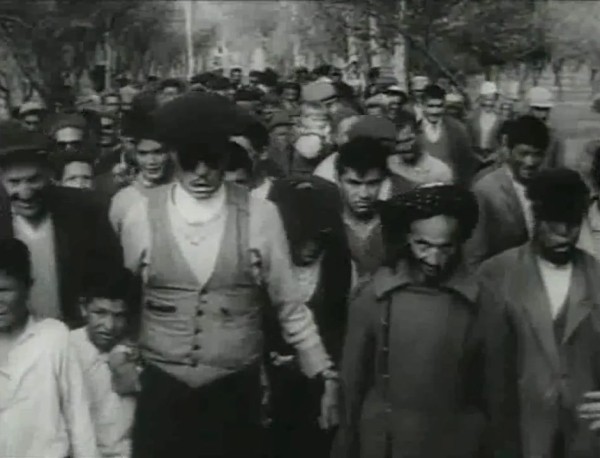
An inability to fully replicate reality is overcome in poetry by the move to abstraction and the use of metaphor. Many claim that unlike textual images, the photographic medium is a space where the replication of the “real” becomes a possibility (indexicality). For poets who work so strongly in the abstract, documentary film opens a space where poetry becomes an actuality, where an “other” could stand in for the self, or the poetic text, and “another birth,” (to use Farrokhzad’s famous poem title), might be imagined. Film is often taken as the realm where reality might stand for poetry and poetry for reality, a place where the power of seeing is fully realized. Like poetry, it is a space where images, like words, are used in similar ways, not so much in creating a pro-filmic world, but to write a poem or social critique in the guise of “ethnography.”
By narrating the film with her own poetry Farrokhzad solves one of Robert Frost’s problems, which is that, “the sentence sound is the heart of good writing,” according to Frost, “and yet it is the one element–_the actual sound of the human voice_–which cannot appear on the printed page.” 17 According to Susan Stewart, “Through poems the human voice reenacts the condition of its emergence from silence and wrests that silence into the inter-subjective domain of made and shaped things. 18 She goes on to explain that, “Dylan Thomas, too with his unsurpassed genius for sound, uses diamond and wing forms in his “vision and prayer” in such a way as to undermine the visual resolution of the work: the problem is an unusual instance of the possibility of putting sound into tension with image in a pattern poem. 19 Which is exactly what Farrokhzad does – both literally and physically. Poetry is another form of image, so in some ways it’s about layering images and voice. The voice is what draws attention to what we should be looking at or seeing. Performance of the voice is as important as the visuals.
The idea of drama is certainly not new to poetry, nor is the notion of performance. “Robert Frost believed that he heard and wrote poetry as drama, performed first by the poet and then by the reader on the theater of the page. He never spoke of dramatic arts as theater art. Rather, he was concerned with the dramatic qualities of writing, how to give to the reader through the medium of the printed word the illusion of dramatic action and presence.” 20 Frost says, “The ear does it. The ear is the only true writer and only true reader.” 21
Sound
The film begins with a dark black screen from which a man’s disembodied voice reminds us that, “There is no shortness of ugliness in the world.” We hear him, but we see nothing as he continues, “If people closed their eyes to it, there would be more. But humans are problem solvers. On this screen will appear a vision of ugliness and pain that no caring human being should ignore.” He warns us, even before the first image is displayed, that it will be unpleasant and that we cannot nor should not ignore it. “The film’s motive is to wipe out the ugliness and relieve the victims.”
As we transition into the next shot, the voice of a young boy comes in: “I thank God…” Thus entails the irony that comes through the juxtaposition of text and image — for what could these lepers possibly have to thank God for?
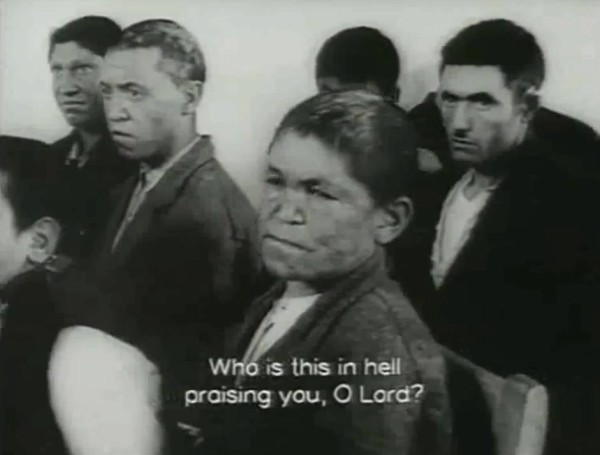
The next shot is a classroom full of boys reading lines from their school books in which they thank God, for parents (that they don’t have), fruits of the earth (that they won’t toil), hands (the boy who reads this line holds his book with finger-less hands), eyes, ears and feet. The moment the camera begins to move (until now we have had solely stationary shots), Farrokhzad’s voice comes in as if to propel the camera forward, as if the very rhythm of the poetry could move the film from scene to scene –image to image. The camera’s movement initiates a slow, penetrating pan over the boys who watch as it moves past them. Farrokhzad’s voice now moves with the camera, over the boys, initiating a visual journey that the smooth poetry will guide. The poet asks: “Who are these people in hell praising you, Oh Lord?” An innocent question? Life is never defined as hell by the lepers, or spoken of at all. The narrative comes solely from the poet, observer, and filmmaker.
The revolution in ethnographic filmmaking began at the turn of the twentieth century with Franz Boas, father of American anthropology, linguistics and sound studies. Boas spent years recording music and language in the field with a wax cylinder. His lasting legacy, and one which was used by Iranian filmmakers in the sixties, was to abandon voices and language in his film recordings and opt for images over narrative. Boas placed his own explanations over the worlds he recorded. He wanted originally to record movement, pure unadulterated movement. Rhythm, sound, dance and trance were the subjects that obsessed documentary makers and anthropologists at the time. Boas set a precedent in the 1890’s of the authoritative voice-over narrative that lasted some seventy years, until James McDougal introduced the first subtitled film. Forty some odd years after Boas, when anthropologists enjoyed celebrity status, those working in the medium of documentary continued Boas’s ban on the native speaker, as teller of his or her own story. Films made during the fifties and sixties lacked the “informant’s” voice and in place of “natives” speaking for themselves, these films provided an authoritative voice-over written by the ethnographer, describing the scene, as if it needed detailed, scientific explanation — as if the images weren’t enough and the “natives” couldn’t speak for themselves. 22
Farrokhzad’s film follows this tradition to a degree by shunning spoken language for humming, gibberish and background noise. The only moment an unscripted sentence is unintentionally left in is when two boys whisper to one another in un-subtitled Turkish (the language of the leper colony). Otherwise the entire narrative of the film is read by Farrokhzad, her scientific foil and a Persian script given to the school boys, leaving the people’s own contribution as secondary background sound that provides evidence of “having been there.” We’ve already discussed a separation between sight and sound/text. Another separation, just as important is also made between sound and noise — between language and found sound or in this case sound that one calls meaningless, but that like an image, produces meaning through a referent, by lending itself to association.
At its inception the documentary tradition was about preserving primitive culture for posterity on film, literally canning it and at the same time scientifically dissecting and explaining the strange and exotic first through inter-titles and then through voice-over narration. It’s here in this moment, between the image and text, between art and science at the inception of ethnographic photography that we are faced with the problem of captioning.
According to Susan Sontag this is where we are demanding that the photograph do something that it cannot do — speak. She says that, “The caption is the missing voice, and it is expected to speak for truth. But even an entirely accurate caption is only one interpretation, necessarily a limiting one, of the photograph to which it is attached.” The problem of captioning of course is nothing compared to the problem of speaking. In the 60’s almost all documentaries are made with voice-over narration, and none of them allow the subjects themselves to voice anything about their own realities. 23
At the same time, Farrokhzad’s film is a real departure from the documentaries of its time in that the narrative voice-over is based almost entirely on a single poem. At the height of this moment in 1967, when few “natives” had ever made a film about their own society, Farrokhzad created a film that was neither a documentary in the scientific sense, neorealist, or social realism, but pure poetry. Her documentary moves away from the style of its contemporaries by nature of the textual poetics and by not making a strong scientific claim. The poetry doesn’t necessarily relay logic so much as it heightens the visual, creating metaphors and allegory. In this she’s a diligent student of socialist filmmaker Sergei Eisenstein, who juxtaposed images to make political statements. Farrokhzad goes further by using the poetic text as a single image that moves against the celluloid images—a montage of film and poetry. In this, as we look at it years later it is no longer a documentary of the Leper colony but a poetic, interior, native documentary about a woman artist in Tehran grappling with issues of science, society and faith at a time when these issues were at stake politically and socially.
The presence of the poet’s voice points to the sections of the film where reality might be made art and where science, religion, education and the clinic are outside the realm of this reality. But it is on the blackboard that the most critical stanza is not spoken, but rather written:
I won’t see the spring
these lines are all that will remain
as the heavens circled, I fell into the bedlam
I am gone, my heart is filled with sorrow, oh Muslims I am sad tonight
This is the only place in the poem where she evokes Muslims. Instead of placing this stanza directly before the scene in a mosque, she places it next to the clinical scene, just prior to the voice-over of a scientist who informs us that leprosy isn’t genetic but rather a curable symptom of poverty. Only two sequences exist without any poetry: the mosque and the clinic. The miseries of leprosy and the failure of religion have been marked. Is leprosy then the wrath of God?
Hers is the only Iranian neo-realist film that directly critiques religion — made over a decade before the Iranian Islamic Revolution. While many of her poems directly implicate religion as failing to solve social problems, it is this film that most directly displays what she often refers to as the ugliness of the world, edited alongside the practice of religious ritual in everyday life.
It is as if the evocation of “Muslim” was too powerfully critical to be read, it had to be “found” among the images that are merely “footage” – the chanced upon objects outside of the poet’s creation. Footage mixed with chance is what allows documentary-making a sort of flexibility in terms of intention. In other words it gives the social activist an out or a way of explaining away powerful material as “found” rather than sought. The footage is thus given to the director by the environment. The placement of this text before the “science” section of the film reinforces the shield of “documentary” against what could be seen as critical footage.
Religion arrives on the scene again as a man in a garden holding his ears the way a mullah does as he calls the faithful to prayer. We hear the call to prayer begin as we watch the man in the garden. This man could be the Mullah until the next shot delivers us to a mosque where we see a real mullah. It is now obvious that the voice of the initial call was not that of the man in the garden, but that of the mullah in the mosque. The placement of the voice of the mullah over the shot of the madman in the garden is a move that could only be done in film and edited as a purposeful “accident” that intensifies the unwritten critique of religion that continues when the real mullah holds up his two deformed hands and praises God.

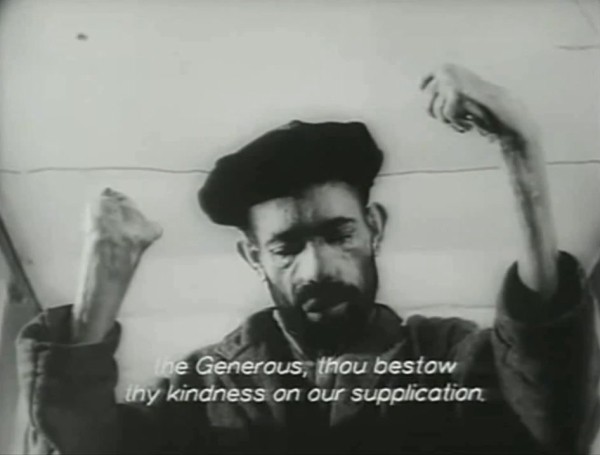
At this point in the film, we have seen our share of deformed hands, and intact hands. The intact hands are mostly thumbing prayer beads: a sign of passing time, counting time and prayer as a way to spend time. Given the visual excess of fleshy hands, the shot of the metal hands of Fatima facing the camera come as a sort of shock. They are a warning, a talisman — object. They are artifice and suggest death in their juxtaposition to the live, if however deformed, fleshy hands that hold them. The hands of Fatima seem even eerier as the camera moves down to the foot of the saint’s tomb where a leper has thrown himself to bestow his thanks and receive blessings. These metal hands that are supposed to ward off the evil eye, in their fleshy presence as deformed leper hands in the film, serve only as a “symbolic” failure of religion. 24 The final mosque shot is of a large empty prayer hall—another sign of religion’s failure, and the absence of believers, if not of God.
When Farrokhzad’s voice returns, it is only to suggest escape:
I said if I had the wings of a dove
I would fly away and be at rest
I would go far away and take refuge in the desert
I would hasten my escape from the windy and stormy tempest
for I have seen misery and wickedness on earth
The next sequence begins with the sound of a wheelbarrow and then the sight of a man pushing it. Where he may have been hulling a load for work, he is carting a little girl and her doll. The scene is followed by more scenes of men who attempt to be productive: long shots of a man smoking a cigarette, or a man trying to light a cigarette that won’t catch as the man with the wheelbarrow squeaks slowly by. She uses the images of prayer beads, the man walking, and people sitting to evoke boredom through repetition. Two main characters return to haunt every stanza: the mad man, who mimics musical instruments with his voice while he taps his feet, and the man who paces the length of a street, day in and day out. As the man paces Farrokhzad whispers the days of the week. Juxtaposing the visual with her voice to heighten the sense of stagnation, idleness, and boredom. Film filters a state of boredom. Even the slow steady rhythm of Farrokhzad’s voice creates a slow real time effect. Photography and poetry cannot convey time quite the way a film can with sound and movement. Farrokhzad utilizes sound in a very productive way to explicate the passing of time, the slow, slow passing of time: nature sounds in the form of echoes, suggesting hollowness, emptiness, a great expanse between the Leper colony and civilization, the sound of her whispering the days of the week, of a rooster — nature’s own clock, a natural tick/tock.
Farrokhzad in an interview says repeatedly “There is so little movement in daily life there.” She says that what impressed her most, and perhaps what she was most bothered by wasn’t just the lack of movement in daily life but the very real possibility of being confronted with one’s self. Perhaps that is what the first shot of the woman starring in the mirror is all about —the horror of having to watch one’s self enfold. But, it’s the women who are productive: cleaning babies, feeding babies, spinning cotton, making things, while the men sit and stare.
Farrokhzad never stays in one location too long without bringing in shots from other locations or sequences. She favors a montage style that can easily juxtapose things like the scars and wounds of leprosy that we first see graphically touched and examined in the clinical scene and then again in the mosque. She uses a style of portrait stills and close-ups to focus on character traits and the aesthetics of leprosy. Most of her shots are of faces, feet and hands. Rarely does she show a whole adult leper’s body, and when she does, he or she is usually sitting or hobbling on crutches or in a wheelchair. The only time we see full adult bodies is when they walk in or out of the frame of the camera. Even then, they are fragmented: missing a leg or part of an arm. The bodies she shows are rarely upright or fully intact. They’re productive body parts, but not fully productive bodies. A sequence of shots show deformed hands moving board game stones, rocking a baby crib, spinning cotton or hobbling on a stumped leg to a place of rest where a waiting child, who should be accustomed to the sight of leprosy, looks away.
The only non-fragmented bodies we see, and the only voices we hear are those of the children—the doves. Children are the marks of normalcy. They are the “prior” of an awful infectious and ugly disease. They are the ones who are at risk, not genetically, but by their mere presence at the colony and proximity to the infectious disease. They are the ones who are the true tragedy, forgotten by society—the ones who could be saved. Throughout the film, we sense Farrokhzad’s horror that children are left in such a place where they will surely contract a disease that is not genetic, but preventable. When she leaves, she adopts a boy to take home.
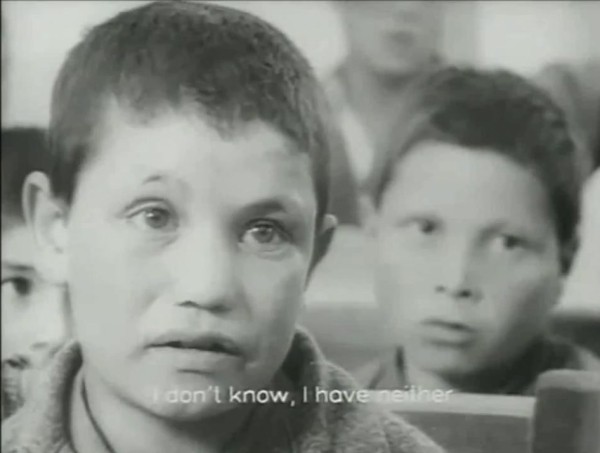
“Everywhere you look, you see children, and more children.” 25 The fact is that the lepers continue to procreate, which Farrokhzad implicates through the very intricate staging and filming of a wedding. The uncanny sense of simulation suggests a sort of unnaturalness to the practice, of a taboo being broken. In an interview Farrokhzad says that until recently marriage was forbidden among lepers. She says that there is however, a great desire for love and sex, especially as “there is nothing better to do than to watch a never-ending eternity.” In twelve days of shooting, they saw four weddings. Even sexual desire masks as a desire to pass time. In an interview with the lepers, Hamid Mahmudi asks the women if they desire gold jewelry. A woman answers that she does want beautiful things, ornaments. What do people who have so little to look forward to want? “Just a fake leg” one man told Farrokhzad, “Just bring me a fake leg from Tehran.”
The wedding scene is typically Iranian. From the musical instruments to the dancing to the suffreh (spread) and even the expression on the women’s faces as they dance and “naz” (a form of coquetry that is part of Iranian dance), the wedding is typical of any village in the region – until they clap with malformed hands. The society and class that Farrokhzad belonged to in Tehran was obsessed with beauty: nose jobs, chin-tucks and weight-loss were and still are of major concern. The viewer approaches the scene imagining a “normal” wedding until the deformities slowly appear: the bride with her overly constructed red cheeks stares glassily at the audience with eyes that fall behind her head like the glass bead eyes of a doll. There is an uncanny feeling of familiarity in the complete strangeness, in the horror of seeing oneself possibly eaten live.
The wedding if nothing else is a nod to documentary, to recording the social, to doing ethnography. And it has the desired effect. All the questions Farrokhzad was asked in the one interview about the film had nothing to do with poetry or filmmaking, but were instead “anthropological” beginning with a question about marriage among lepers. Farrokhzad wasn’t asked why she chose certain images or whether she wrote the poem before or after the footage was gathered or edited or whether the edits were structured along the lines of the poem, (the stanzas of this poem could easily be switched around, as could the non-chronological images—there isn’t a plot driving the movement). She wasn’t asked whether she told the children what to read or how much of the scenes were staged or whether the film was a political statement. By asking a question about social relations among the lepers, the interviewer places Farrokhzad in the realm of ethnography and “science” which points to the success of her method of using ethnography as a foil for political commentary. She does try in the interview to bring the discussion back to one of aesthetics and politics by saying that, “The worst deprivation of leprosy is the lack of a human face.” 26 As Deleuze says, “The face is a politics.” 27
What Farrokhzad achieves cinematically is a very serious critique of Iranian society. She asks us to save the children, the next generation, who are yet to be infected. Her film illustrates how imagery as a direct metaphor for a social disease (leprosy) coupled with a poem that is isolated from the images (thus never implicating or naming the problem or a subject in the critique), might be an effective way to use art and anthropology for political ends in a society with strict censorship. Photography provides the “real” encounter with a said metaphor, where poetry might be thinly veiled and thus protected. In the two moments that are most poignant, when the poem becomes a material image of itself as script on the blackboard (and thus not voiced) we learn that Moslem society is in trouble, that indeed, the house, surely just a metaphor, is black. Leprosy is pointed to, documented, named as such, as “the real,” but the house is not the leper colony, for those doors, as we shall see, close before the movie ends and another house, society, is named black.
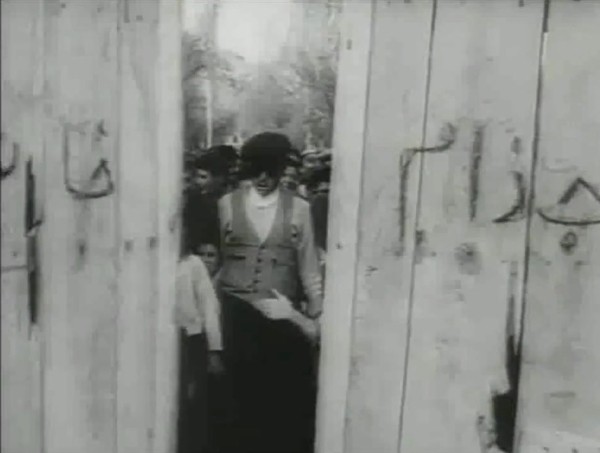
While the film may not have had a large audience or any distribution after its few appearances in Venice and Tehran, the real success of the film lies in the fact that not only was it never banned, but it brought the very audience member it most threatened, The Shah, to tears. If only for a moment, and even if for show, The Shah fell under the spell of imagery and poetry that worked with and against one another to critique the very ground he stood on.
Works Cited
Clark, Hodson, Neiman. The Legend of Maya Deren, VI, Part two, 16. Anthology Film Archives, New York, 1984.
Deleuze, Gilles. Thousand Plateaus: Capitalism and Schizophrenia 1987: University of Minnesota Press.
Eisenstein, S. Film Form, 1949, trans. Jay Leyda, 1977. Harcourt and Brace, NY.
Hillman, M. A Lonely Woman: Forugh Farrokhzad and her poetry. Washington, D.C. : Mage Publishers : Three Continents Press, 1987.
Mahmudi, Hamid. “Interview with Forough Farrokhzad,” 1965.
Neiman, Catrina. “An Introduction to the Notebook of Maya Deren, 1947.” Art and Anthropology: The Crossroads, 14 (1980): 3-15
Stewart, Susan. Poetry and the Fate of the Senses, University of Chicago press, 2002
Thompson, Lawrence. editor, _Selected letters of Robert Frost-, New York, 1964. P. 151.
Vander Ven, Tom. “Robert Frost’s Systematic Principle of Over Sound,” American Literature, Volume 45 number 2 May 73.
Wolpe, Sholeh, translator. Sin, Selected poems of Forough Farrokhzad, University of Arkansas Press, Fayetteville, 2007.
Notes
- Varzi, 2014, “Keeping it Real: ‘Reality’s’ role in the production and reception of independent Iranian cinema” Film International, Issue 69, pp. 77-86. ↩
- Hillman, M. A Lonely Woman: Forugh Farrokhzad and her poetry. 55. ↩
- The most stunning scene evoked in the interview about the film is at the first Iranian screening of the film at a medical college, when Farrokhzad, her lover (and co-editor, Golestan) and his wife are called over the loud speaker to report to the Shah’s private box. None of them budge. Finally they are forced to go. When they arrive at the Shah’s seats, he and Queen Farah are gushing with tears and sympathy for the poor lepers. Farrokhzad called it a most pathetic scene. ↩
- In her biography by Michael Hillman, A Lonely Woman, only half a page is dedicated to the documentary. The only text written about the film when I first began researching it in 1998 was a two-page article by Hamid Mahmudi, written twenty-five years after the film was made. The article includes interviews with the few remaining members of the leper colony who had participated in the film, as well as an old interview with Farrokhzad twenty-five years ago. ↩
- Deleuze 1987: 172 ↩
- Wolpe, 65. ↩
- The film had to include some aspect of scientific evidence or proof of technological advances, because the Shah, who funded it, wanted to show evidence of scientific advancement. Which is why so many artistic filmmakers in the 50’s through the 70’s made films about oil refineries, leper colonies and car factories (with a twist). ↩
- Eisenstein, S. Film Form, 1949, trans. Jay Leyda, 1977. Harcourt and Brace, NY. ↩
- Advocacy films were also shot almost like silent films with a strong voice-over narrative added to get the point across (like Luis Buñuel’s Land Without Bread). Again Iran’s visual history stays in tune with this shift if for no other reason than the fact that another oil rich monarch was able to send his best and brightest subjects abroad for training in the cinematic arts. We see the advocacy angle appear quite strongly in Iranian documentaries by the sixties, especially in Farrokhzad’s documentary, which moves away from recording to provoking. ↩
- Hillman, 69. ↩
- From interview with Mohamed Taghi Salehpour, quoted in Wolpe, xxix. ↩
- Clark, Hodson, Neiman. Poet/filmmaker, Russian Immigrant, Maya Deren, was experimenting in film and language in similar ways. She too was a woman artist passionately interested in the social, and in experimenting in the “science” of ethnography. Deren also began as a poet (unpublished). Her book The Divine Horseman and the Living God’s of Haiti is probably her most important work though her notoriety is as an experimental filmmaker. What is provocative about Deren’s work is that she chose ultimately to favor a textual representation of her work in Haiti over a filmic one. She was worried that the images would be misinterpreted, where as a written ethnography would not. Her movie, which was the reason for her initial travels to Haiti, was only edited posthumously using her book for the script. ↩
- Clark, Hodson, Neiman. ↩
- Ibid. ↩
- Neiman, 13 ↩
- Ibid, 13 ↩
- Vander Ven, 43. ↩
- Stewart, 77. ↩
- Ibid, 77. ↩
- Vander Ven, p. 43. ↩
- Thompson, 151. ↩
- Voiceless subjects are found in films like Les Maître Fous by Jean Rouch, Trance and Dance in Bali by Margaret Mead and Gregory Bateson and The Divine Horseman and the Living Gods of Haiti by Maya Deren (in which the voice-over is scripted from her narrative work of the same title). ↩
- Sontag 109. ↩
- As an anthropologist looking at the footage as footage outside of the filmic juxtapositions that clearly point to a critique of religion, I might say that the leper’s actions could also be read as immense belief and gratitude in the face of a grave situation – which isn’t how the filmmaker is reading it. ↩
- Interview with Hamid Mahmudi in 1965. ↩
- Hamid Mahmudi, 1965. ↩
- Deleuze 1987: p. 172 ↩

